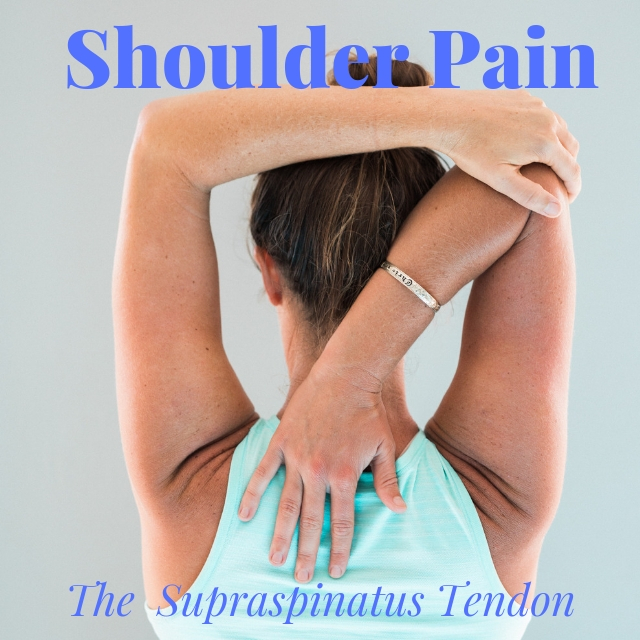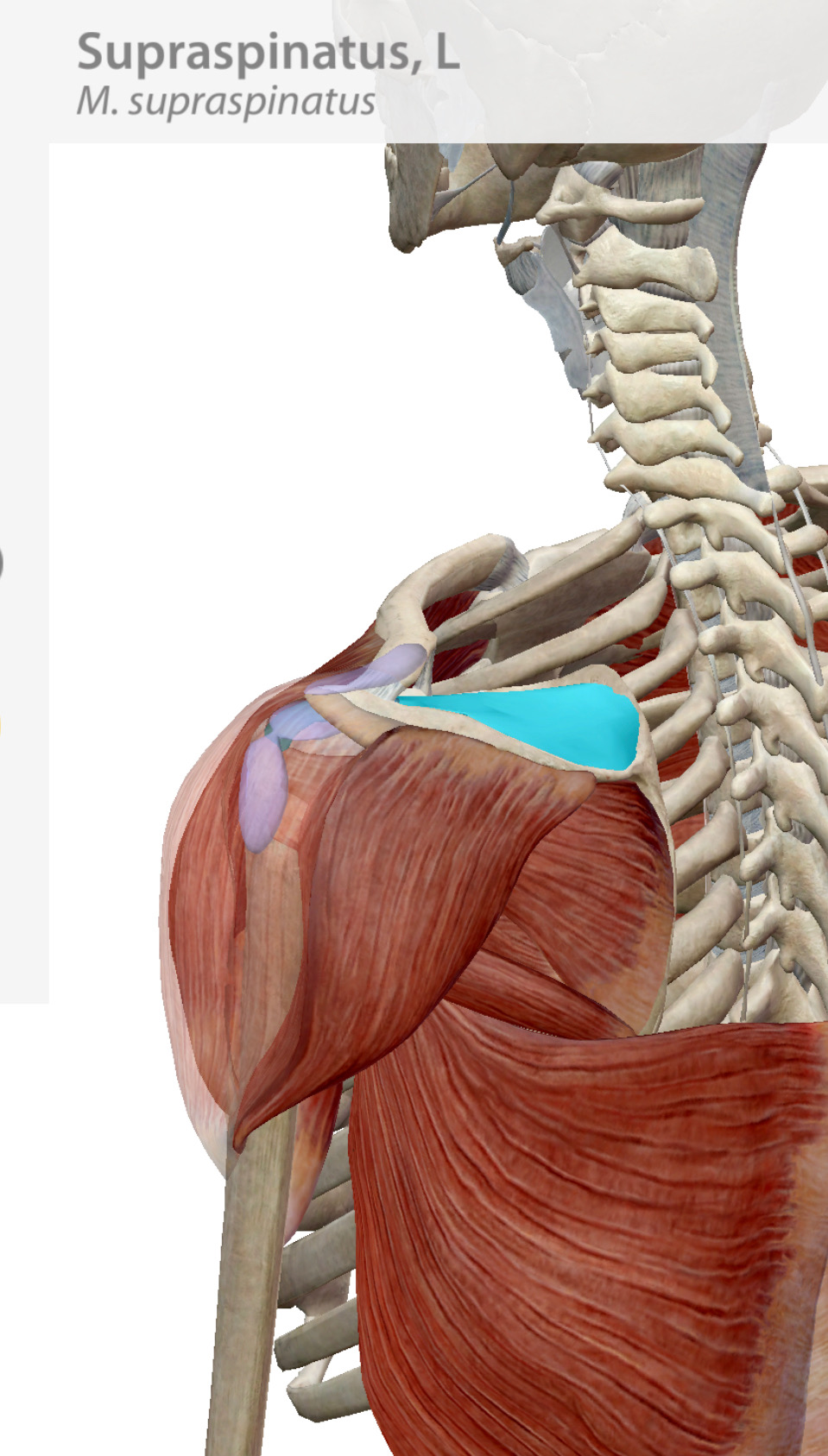Move Better In Your Body
Welcome to Part II of my Shoulder Pain series. Today we will be discussing the Supraspinatus Tendon. Where it is located, what movements it is responsible for and how it can wreak havoc on the shoulder and scapulothoracic joint, especially if you are an overhead throwing athlete…
So Where is it?
The supraspinatus muscle attaches to the supraspinatus fossa and inserts at the greater tubercle of the humerus. This muscle is quite complex due to where it is positioned and how its tendinous attaches travels beneath the clavicle and acromion process to attach to the superior and anterior portion of the humerus.
What does it do?
This muscle acts as one crucial part of four of the rotator cuff group. The supraspinatus’s job is to stabilize the glenohumeral joint and primarily does the first 10 degrees of abduction and finishes with the last 10 degrees of abduction when lifting your arm overhead. So if you need to grab something off the top shelf in your kitchen, or push your car door open, you will be using this tiny muscle.
Innervation: Suprascapular nerve at C5/C6
Lets think about location of where this nerve is placed. Do you think upper back and neck pain have anything to do with dysfunction of the supraspinatus? Most definitely.
The primary nerve pathway of the suprascapular nerve takes when it is compromised is from the top of the shoulder and down the outside or lateral portion of the arm. If you have ever experienced any type of nerve entrapment, there tends to be an myriad of issues that pop up.
Including pain when lifting anything overhead, bringing your shoulder from external rotation to internal rotation behind your back and numbness or tingling that radiates down the arm.
Calling All Overhead Throwing Athletes
In any repetitive movement that involves the shoulder, the supraspinatus needs to play its roll in allowing the shoulder to horizontally abduct to then allow the shoulder to elevate, externally rotate and decompress as you throw and then return to an starting position. In an recent study by Lay Sein, et al., where competitive swimmers were evaluated, with increased load, intensity and duration, in result tendinopathy, impingement and shoulder pain increased over time.
What do you do at practice as an baseball pitcher? You throw the ball over and over again, increasing repetitive stress placed on your rotator cuff and supraspinatus tendon. Now think of any repetitive motion you may be subconsciously doing throughout the day, sleeping on one side, driving with one side of your body? Any and all repetitive movements could be creating less space in your shoulder.
We are all on the same team!
What happens when your shoulder gets tired after throwing 50-100 pitches? What happens when your rotator cuff is worn down and can’t take the brunt of the force anymore?
Anatomical Structures working together:
Rotator Cuff
Scapulothoracic Joint
Glenohumeral Joint
Acromioclavicular Ligament
Coracoacromial Ligament
Energy leak in the system….
If you are experiencing any dysfunction in the shoulder joint (glenohumeral joint) in any movements of lifting overhead, and or bringing your arms behind your back, any structure listed above will attempt to pull the weight for the rest of the team. Whether that be your posterior rotator cuff working for the anterior muscles and ligaments of your shoulder. Or you may be limited in your thoracic spine mobility which places the force output on just your shoulder joint when attempting to throw a fast pitch over and over and over again.
In an study by Michener and McClure, weak or dysfunctional rotator cuff musculature,, posterior glenohumeral capsule tightness, and poor thoracic spine mobility may lead to or cause subacromial impingement, which is in close relation to the supraspinatus tendon.
How Can You Prevent Supraspinatus Tendon Pain? And have all your parts perform well together?
Sub Acromial Space:
Create space in your sub acromial space and learn how to depress your scapulae. Remember your supraspinatus attaches directly under your clavicle and acromion. When dysfunction occurs, there is in turn less space in this area.
Check out this video here
Remember where your suprascapular nerve innervates? C5/C6. Improving your upper back and mid thoracic mobility will improve how the rest of your shoulder and scapula moves.
Check out this video here
Learn How everything is connected together by going through an Cog Assessment
When we check out issues in the supraspinatus ligament we look local, but we also need to understand global patterns are taking place. Your Right Shoulder works directly with your Left Hip in Gait Patterns. Getting all your parts working together and feeling what movements may be missing in your body are vital in unravelling bigger issues.
Dealing with any shoulder impingement issues? Make an appointment here
Want to get updates on upcoming workshops that directly give you these tools in person, join my tribe and get updates on upcoming In person workshops.
Alright that is it for now. Join us next week for our third part in this series, Shoulder Pain and the Posterior Rotator Cuff.
Sources:
- Yuoheti, Yilihamu. Itoi, Ejii. “Apoptosis in the supraspinatus tendon with stage II subacromial impingement.” Journal of Shoulder and Elbow Surgery 14.5 (2005) 535-541.
- Payley, Kevin., Jobe, Frank., Pink, Marilyn., et al. “Arthroscopic Findings in the Overhand Throwing Athlete: Evidence for Posterior Internal Impingement of the Rotator Cuff.” The Journal of Arthroscopic and Related Surgery 16.1 (2000) 35-40
- Lay Sein, Mya., Walton., Judie., Linklater, James., et al. “Shoulder pain in elite swimmers: primarily due to swim-volume-induced supraspinatus tendinopathy.” British Journal of Sports Medicine 44 (2010) 105-113.

